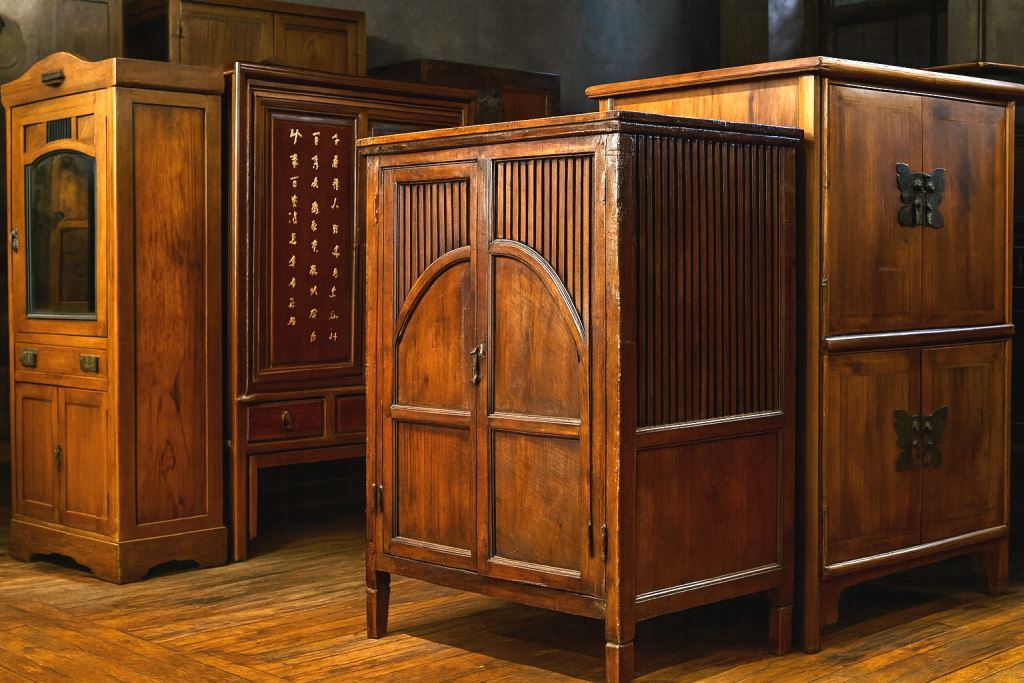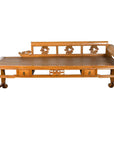

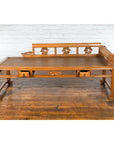
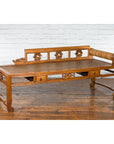
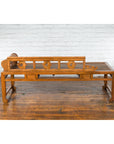
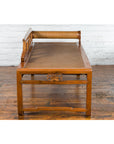
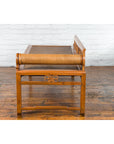
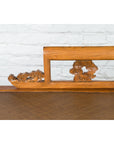
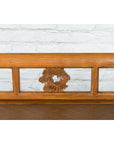
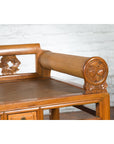
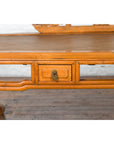
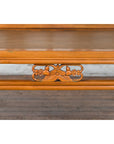

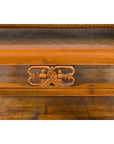
Qing Dynasty 19th Century Lady's Opium Daybed with Rattan Seat and Pillow
✔ In-stock. Ships in 3–5 days direct from FEA Home
A Chinese Qing Dynasty period wooden lady's opium bed from the 19th century, with rattan seat, pillow, two small drawers and auspicious carved cloudy motifs. Created in China during the Qing Dynasty period in the 19th century, this opium daybed features a removable pierced back adorned with auspicious carved cloud motifs, connected on one of its sides to an arm covered with rattan (and also removable), made for the opium den customer (in this case for a lady) to recline her head against. The history of opium dens started some 300 years ago and is rooted in the trade relations between England and China. Opium dens in the 19th century catered to all layers of society, but differed in furnishings and attendants.
Rich customers would lay on a bed and rest their head on opium pillows made either of wood, leather or porcelain. After a little while, the pillow felt like a cloud. The seat here is also covered in rattan and is resting on a pierced apron with humpback stretcher, carved with a delicate floral décor flanked with two small drawers. The ensemble is raised on four legs with scrolling feet, connected to one another through humpback stretchers on the sides. With its carved décor and warm patina, this Qing Dynasty 19th century opium daybed will make for a great decorative addition to any home, particularly placed in a living room.
Age: Antique
Origin: China
Each piece is unique with natural variations in age and appearance that add to its character.
Every order ships fully insured and handled with care, with white-glove service available nationwide.
- 24-hour grace period to cancel your order
- Returns accepted within 72 hours of delivery, in original condition and packaging; a 25% restocking fee applies
- Buyers are responsible for return shipping costs; original shipping fees are non-refundable
- Damage reported within 72 hours qualifies for a full refund
Exclusions apply. See full policy for details.
- Each piece is hand-selected for rarity and character
- Professionally delivered, expertly handled
- Personal guidance from our in-house team
- Trusted by collectors and designers since 1962
Print Tear Sheet

Contact FEA Home to Order
- Phone: 914-423-3380
- Email: Info@FEAhome.com
- Website: https://www.FEAhome.com
FOR DESIGNERS
Work With FEA Home
Unlock exclusive trade pricing, personalized service, and early access to one-of-a-kind arrivals - all tailored to interior professionals.

FOR PRODUCTIONS & EVENTS
Style Your Scene
Rent rare vintage furniture and statement décor for film, TV, events, and editorial - fast, flexible, and unforgettable.

FAQ's
Yes, we're happy to provide additional images or a short video. Click the “Email Us” icon above to open our quick contact form - it will send your inquiry directly to our team with this item’s details.
All items are available to view in our Yonkers, NY showroom. Contact us to schedule a private appointment or confirm availability.
We ensure secure and professional packing for safe delivery using:
- UPS – For smaller items
- Freight Carriers – For larger pieces
- White Glove Delivery – Includes unpacking and placement in your home
- All shipments are fully insured
Visit our Orders, Shipping & Returns page for more information.
For shipping outside the USA, contact us for a shipping quote.
We want you to feel confident in your purchase. Returns may be initiated within 72 hours of delivery if the piece is in its original condition and packaging; a 25% restocking fee applies. If your item arrives damaged, please report it within 72 hours for a full refund.
Read Full Policy →
Contact us to request an exchange or report damage.
Yes, we support designers, stylists, and stagers. Learn more about our Trade Program or Rental Services.
We can reserve select items for up to 72 hours. Click the “Email Us” icon above to open our quick contact form - it will send your inquiry directly to our team with this item’s details.
Most orders ship within 3-5 business days. Tracking to be provided upon shipment.
LOOKING FOR SOMETHING UNIQUE?
Let’s find the perfect piece for your home
Our team is here to help you discover timeless, one-of-a-kind décor.
